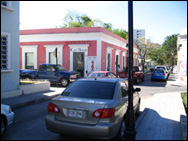
Cafe Major
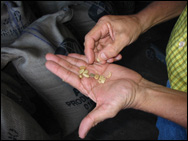
Wastrel Chico shows his stuff
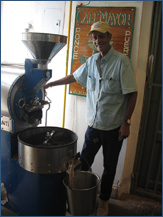
Mighty Angelo
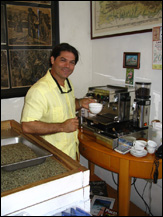
Don Luis
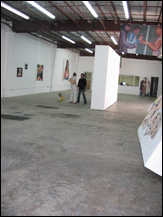
P Vélez at Galería Comercial
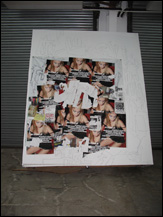
A nice play of scale
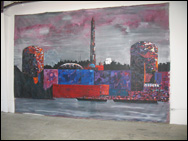
J Zeno & P Vélez in “Godfuck”
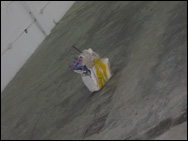
A detail

It may be hot, dry, and a frightful snooze, but Ponce, the Ruined Glory of the South (RGS por sus siglas en inglés) has the best coffee on the island, por mucho. That would be Café Mayor, selected, toasted, and packaged with saintly devotion by Luis Valdejuly Sastre and his jolly compadres, Mighty Angelo and the highly inimitable Wastrel Chico.
Visit the bustling, odoriferous Café Mayor command center, a few blocks south of the central plaza, and you’ll believe you’ve fallen down one of the better Rabbit Holes of Borinqueño Delights, of which there are just seven on the entire island. (Each burrow contains a different criollo specialty, not all of them top notch. Avoid at all costs Tapón World, from which you may never return.)
Café Mayor is not, in fact, one of the delicias, but it’s better in every respect. The product is smooth and flavorful. The place is a shady retreat from the scorching Ponceño sun. You are treated kindly by smiling subalterns. You get the proper change. Very groovy machinery grinds happily over whatever knickknacks are playing on the stereo. And a highly sociable disorder prevails, barely kept under control by the steady ministrations of Mighty Angelo. The air positively buzzes with a productivity that could be earning the principals considerable sums from illicit substances, corrupt practices, or greasy empanadillas with Nescafé, making them all wealthy, unpleasant sourpusses. Bravo.
We’ll follow the changing fortunes of la Banda de Luis (also known among coffee aficionados as “los Auténticos”) whenever we have occasion to venture to the godforsaken reaches of the RGS.
Do you, like many folks beyond the navel-picking fringes of the art world, ever wonder why artists bother? Check out the aptly named “Godfuck” at Galería Comercial, and ask yourself like you’ve never asked before. It isn’t that artist-provocateur Pedro Vélez hasn’t got a wonderful flair for the off-putting and the hard-to-get. And don’t think for a minute that he isn’t encouraged in his spot-on obscurantism by those who probably know better, but might not. In fact, if you have the good fortune to listen to Pedro for a few minutes, you’ll go away convinced that there is some there there.
People have said, “Con Pedro, él dice estas cosas y son todas mentiras,” which, strictly speaking, misses the boat. Pedro Vélez speaks metaphorically, although we’re damned if we can grasp, in the end, just what it’s a metaphor for: the bruised pubescent girls, the rhythmless faux language, the obvious art world gags and found, doodled-on images from the trash barrel of kitsch. Are we looking at bored, enervated youth culture in PR? Art world bankruptcy and the too-fussy, too-crafty drift of things? The foolishness of gallery-goers and the degenerate intentions of the gallery-museum-collector axis? Perhaps a balls-up-balls-out attack on the myriad swindles of capitalism itself.
On the other hand, you can see that although the collaborationist aesthetic seems entirely pointless, that’s far from the case. Pedro has explained, with no small satisfaction, that the paintings—daubed with some effort by Jorge Zeno, and quite good—are based on photographs the two of them staged, and that Pedro has, with his own hand, placed pieces of paper on the paintings. If that’s not collaboration, sue me.
It’s all a heartbeat this side of delgado, flojo, and a la chingada, and is almost entirely redeemed by a little hunk of broken concrete at mid-gallery, which has a story behind it. (We’re not giving anything away, cabrón. You have to see it for yourself.) The entire exhibition sports a slew of stories, apparently; but these are mostly after the fact, not real stories at all, but what the pointy-heads might call “self-justifications.”
Ripe. But is it ready?
Avenida Fernández Juncos #1412. Best to call ahead at 787-274-0655.
You missed it. Rafael Ferrer’s “Etcétera” at Galería Petrus, which came down just last week. Funny, often nasty wordplay that you can’t avoid getting, painted by a master. Among the ton of works, a series of little blackboards, à la Torres Llorca, sporting the Ferrer versions of typical blackboard fare: today’s menu, cracked slogans, naughty puns. I’ll have the condones rellenos, please.
Entering the Petrus fastness always makes me want to purse my lips and utter haughty deprecations about the unwashed masses, but I can’t deny that the program sometimes rises to the near-sublime.
Bracing.
The large-scale photographic close-ups of crowds watching unseen events, by Carlos Ruiz Valarino—up until around the third week of April at Galería Raices—are crisp, small dramas of people in the throes. Ruiz Valarino has learned something from Philip Lorca diCorcia about the theatrical potency of a cool, distant gaze, but recent history tips the best of these tableaux in the direction of mass disbelief and hysteria. The collage technique is complicated and the craftsmanship impeccable, making certain expectant faces the sharp, telling details in the unfocused disturbance all around them.
Avenida José de Diego #316. Phone 787-723-8909.
Seis tipos: tagROM is a name for our time, isn’t it. Digital-sounding, almost memorable, it could be a company of cyber-miscreants dedicated to kidnapping the domain names of respectable corporations, government entities, and vapid celebrities and offering not to sell them to porn sites for hefty ransoms. Or is that done anymore? The name may or may not automatically come to mind when you think “alternative exhibition space,” but tagROM is, in fact, un espacio muy genial, with the program más quijotesco y excelente en el pueblo, as one expert told me. And I believe him. Again this month, co-directors Carlos Reyes and José Estarellas have chosen judiciously, if somewhat haphazardly, to make a highly satisfying array in their spartan third-floor redoubt over Estarellas’ dad’s print shop. They’ve also reached deeper than ever into familiar territory, with artists whose work is well-known by local standards, like Dhara Rivera and Jorge Román. This is no knock on the boys. It’s a nifty exhibition of good pieces by the six artists. Rivera’s arched paper cutout scaffolding and its shadow, an unusually frosty photo portrait by Carlos Ruiz Valarino, and Reyes’ own fatiguing but funny video of a soldier and his pogo stick are standouts.
What ho.
Calle Guyama #13 in Hato Rey, near where Domenech becomes Guayama. The night time is the right time for tagROM, especially opening night.
While we’re tipping the gorro, I like to give Pedro Vélez a hard time, and, who knows, it could make him a better person. But I owe Pedro un chorro de lechones for alerting me to the more outré aspects of the remarkably lively gallery scene in San Juan and vicinity, which I learned about partly from his story for the web magazine artnet. You, too, can partake of the man’s pico de oro here. In upcoming installments of Rotund World, we’ll hit two other excellent spaces mentioned by Pedro, the gallery =Desto and the Caguas hotspot, ÁREA, both run by artists seeking ways to remedy the disgraceful lack of institutional support for the local contemporary art scene (my thought, not necessarily theirs). And speaking of vale la pena, we’ll talk about “The S Files” and Allora and Calzadilla’s latest videos at the Museo de Arte de Puerto Rico.
For now, here’s a final recommendation: “Autocontemplación,” curator Flavia Marichal Lugo’s quite serious but ultimately fun exhibition of self-portraits by Puerto Rican artists, from the late nineteenth century to the early twenty-first. It’s open until the end of May at the Museo de Historia, Antropología, y Arte at the Universidad de Puerto Rico, Rio Piedras campus. “Autocontemplación” is at once an elided but nonetheless provocative who’s who, a compendium of artistic styles, and an amusing game of self-regard. Elizam Escobar, always glorious, always problematic, is there. The sine qua non of early twentieth century Puerto Rican artists, Ramón Frade, peering through a surveyor’s level while two country boys look on. A strapping Lorenzo Homar striding along the beach at Ocean Park in skimpy shorts, exercise paraphernalia in hand. José Rosa in his usual santo-pecador pose, surrounded by a snake’s nest of words. Myrna Baez as a young bohemian.
Hanging amidst the self-portraits is, oddly, Francisco Oller’s towering classic, “El Velorio.” This was my first opportunity to view that strange and vivid spectacle of late-nineteenth century Puerto Rican country life, and it’s hard to imagine getting enough of it.
On with the show.
The museum is very near the main entrance to the university, beside the Biblioteca José M Lázaro. Phone 787-764-0000, extension 5852 or 2452, if you have any doubts about finding the place. Back to the Rotund World main page? Here. Wacky fun? Here you go.